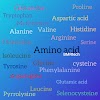Leucine Amino Acid | Introduction | Structure | Chemical Properties | Sources.....
LEUCINE AMINO ACID
Leucine (symbol Leu or L) is an essential amino acid that is used in the biosynthesis of proteins. Leucine is an α-amino acid, meaning it contains an α-amino group, α-carboxylic acid group, and a side chain isobutyl group, making it a non-polar aliphatic amino acid.
Or
L-leucine is the L-enantiomer of leucine. It has a role as a plant metabolite, an Escherichia coli metabolite, a Saccharomyces cerevisiae metabolite, a human metabolite, an algal metabolite and a mouse metabolite.
It is a pyruvate family amino acid, a proteinogenic amino acid, a leucine and a L-alpha-amino acid. It is a conjugate base of a L-leucinium. It is a conjugate acid of a L-leucinate. It is an enantiomer of a D-leucine. It is a tautomer of a L-leucine zwitterion. Leucine is one of nine essential amino acids in humans (provided by food), Leucine is important for protein synthesis and many metabolic functions. Leucine contributes to regulation of blood-sugar levels; growth and repair of muscle and bone tissue; growth hormone production; and wound healing. Leucine also prevents breakdown of muscle proteins after trauma or severe stress and may be beneficial for individuals with phenylketonuria. Leucine is available in many foods and deficiency is rare. It is essential in humans, meaning the body cannot synthesize it: it must be obtained from the diet. Human dietary sources are foods that contain protein, such as meats, dairy products, soy products, and beans and other legumes. It is encoded by the codons UUA, UUG, CUU, CUC, CUA, and CUG.
Like valine and isoleucine, leucine is a branched-chain amino acid. The primary metabolic end products of leucine metabolism are acetyl-CoA and acetoacetate; consequently, it is one of the two exclusively ketogenic amino acids, with lysine being the other. It is the most important ketogenic amino acid in humans. Leucine and β-hydroxy β-methylbutyric acid, a minor leucine metabolite, exhibit pharmacological activity in humans and have been demonstrated to promote protein biosynthesis via the phosphorylation of the mechanistic target of rapamycin (mTOR).
Chemical formula :- C6H13NO2
Molar mass :- 131.175 g·mol−1
Acidity (pKa) :- 2.36 (carboxyl), 9.60 (amino)[1]
Magnetic susceptibility (χ) :- -84.9·10−6 cm3/mol
Thermodynamic data :- Phase behavior (solid–liquid–gas)
Structure-
Sources :-
Whey protein concentrate, dry powder
Soy protein concentrate, dry powder
Pea protein concentrate, dry powder
Soybeans, mature seeds, roasted, salted
Hemp seed, hulled
Beef, round, top round, raw
Peanuts
Fish, salmon, pink, raw
Wheat germ
Almonds
Chicken, broilers or fryers, thigh, raw
Chicken egg, yolk, raw
Oats
Edamame (soybeans, green, raw)
Beans, pinto, cooked
Lentils, cooked
Chickpea, cooked
Corn, yellow
Cow milk, whole, 3.25% milk fat
Rice, brown, medium-grain, cooked
Milk, human, mature, fluid
Synthesis :- Synthesis in non-human organism
Leucine is an essential amino acid in the diet of animals because they lack the complete enzyme pathway to synthesize it de novo from potential precursor compounds. Consequently, they must ingest it, usually as a component of proteins. Plants and microorganisms synthesize leucine from pyruvic acid with a series of enzymes:
Acetolactate synthase
Acetohydroxy acid isomeroreductase
Dihydroxyacid dehydratase
α-Isopropylmalate synthase
α-Isopropylmalate isomerase
Leucine aminotransferase
Synthesis of the small, hydrophobic amino acid valine also includes the initial part of this pathway.







0 Comments